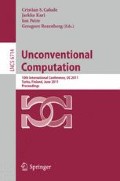Abstract
This paper continues the research on determining a maximum cardinality set of edge- and node-disjoint paths between a source cell and a target cell in P systems. With reference to the previously proposed solution [3], based on depth-first search (DFS), we propose a faster solution, based on breadth-first search (BFS), which leverages the parallel and distributed characteristics of P systems. The runtime complexity shows that, our BFS-based solution performs better than the DFS-based solution, in terms of P steps.
Access this chapter
Tax calculation will be finalised at checkout
Purchases are for personal use only
Preview
Unable to display preview. Download preview PDF.
References
Cormen, T.H., Stein, C., Rivest, R.L., Leiserson, C.E.: Introduction to Algorithms, 3rd edn. The MIT Press, Cambridge (2009)
Dinic, E.A.: Algorithm for solution of a problem of maximum flow in a network with power estimation. Soviet Math. Dokl. 11, 1277–1280 (1970)
Dinneen, M.J., Kim, Y.B., Nicolescu, R.: Edge- and node-disjoint paths in P systems. Electronic Proceedings in Theoretical Computer Science 40, 121–141 (2010)
Edmonds, J., Karp, R.M.: Theoretical improvements in algorithmic efficiency for network flow problems. J. ACM 19(2), 248–264 (1972)
Ford Jr., L.R., Fulkerson, D.R.: Maximal flow through a network. Canadian Journal of Mathematics 8, 399–404 (1956)
Goldberg, A.V., Tarjan, R.E.: A new approach to the maximum flow problem. Journal of the ACM 35(4), 921–940 (1988)
Ionescu, M., Sburlan, D.: On P systems with promoters/inhibitors. Journal of Universal Computer Science 10(5), 581–599 (2004)
Kozen, D.C.: The Design and Analysis of Algorithms. Springer, New York (1991)
Lynch, N.A.: Distributed Algorithms. Morgan Kaufmann Publishers Inc., San Francisco (1996)
Martín-Vide, C., Păun, G., Pazos, J., Rodríguez-Patón, A.: Tissue P systems. Theor. Comput. Sci. 296(2), 295–326 (2003)
Nicolescu, R., Dinneen, M.J., Kim, Y.B.: Structured modelling with hyperdag P systems: Part A. Report CDMTCS-342, Centre for Discrete Mathematics and Theoretical Computer Science, The University of Auckland, Auckland, New Zealand (December 2008), http://www.cs.auckland.ac.nz/CDMTCS/researchreports/342hyperdagA.pdf
Nicolescu, R., Dinneen, M.J., Kim, Y.B.: Structured modelling with hyperdag P systems: Part B. Report CDMTCS-373, Centre for Discrete Mathematics and Theoretical Computer Science, The University of Auckland, Auckland, New Zealand (October 2009), http://www.cs.auckland.ac.nz/CDMTCS//researchreports/373hP_B.pdf
Nicolescu, R., Dinneen, M.J., Kim, Y.B.: Towards structured modelling with hyperdag P systems. International Journal of Computers, Communications and Control 2, 209–222 (2010)
Nicolescu, R., Wu, H.: BFS solution for disjoint paths in P systems. Report CDMTCS-399, Centre for Discrete Mathematics and Theoretical Computer Science, The University of Auckland, Auckland, New Zealand (March 2011), http://www.cs.auckland.ac.nz/CDMTCS//researchreports/399radu.pdf
Păun, G.: Membrane Computing: An Introduction. Springer-Verlag New York, Inc., Secaucus (2002)
Păun, G.: Introduction to membrane computing. In: Ciobanu, G., Pérez-Jiménez, M.J., Păun, G. (eds.) Applications of Membrane Computing. Natural Computing Series, pp. 1–42. Springer, Heidelberg (2006)
Păun, G., Centre, T., Science, C.: Computing with membranes. Journal of Computer and System Sciences 61, 108–143 (1998)
Seo, D., Thottethodi, M.: Disjoint-path routing: Efficient communication for streaming applications. In: IPDPS, pp. 1–12. IEEE, Los Alamitos (2009)
Author information
Authors and Affiliations
Editor information
Editors and Affiliations
Rights and permissions
Copyright information
© 2011 Springer-Verlag Berlin Heidelberg
About this paper
Cite this paper
Nicolescu, R., Wu, H. (2011). BFS Solution for Disjoint Paths in P Systems. In: Calude, C.S., Kari, J., Petre, I., Rozenberg, G. (eds) Unconventional Computation. UC 2011. Lecture Notes in Computer Science, vol 6714. Springer, Berlin, Heidelberg. https://doi.org/10.1007/978-3-642-21341-0_20
Download citation
DOI: https://doi.org/10.1007/978-3-642-21341-0_20
Publisher Name: Springer, Berlin, Heidelberg
Print ISBN: 978-3-642-21340-3
Online ISBN: 978-3-642-21341-0
eBook Packages: Computer ScienceComputer Science (R0)

